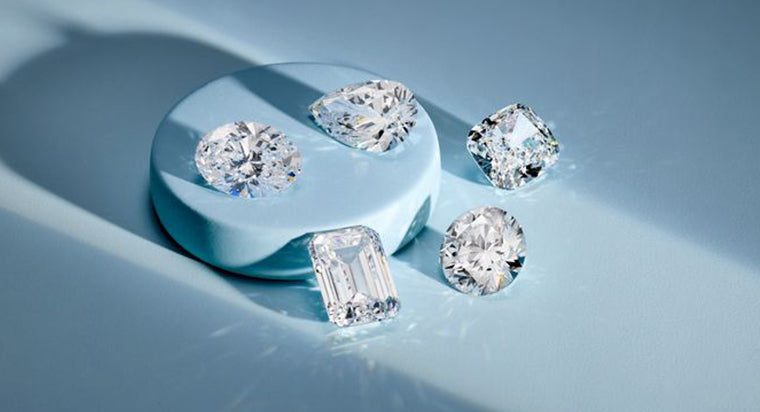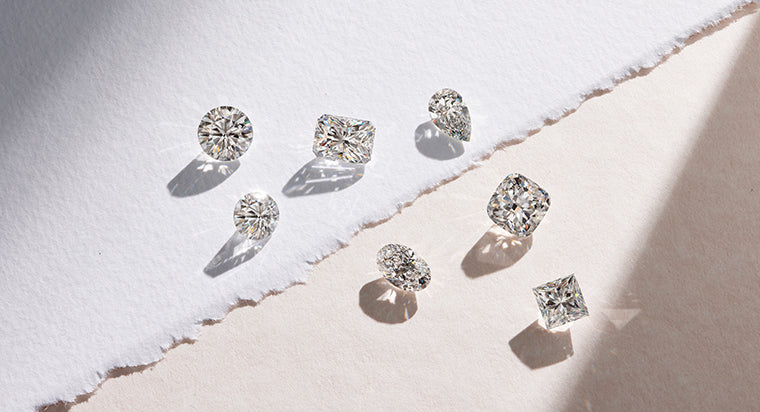D Color Diamonds: What Do They Look Like, And Are They Worth The Cost?

When you're evaluating diamond colors, you'll definitely hear the term D color diamonds thrown around a lot.
You aren't hearing things: D color diamonds rate the highest on the color scale for diamonds, meaning they're completely colorless. Sometimes called white diamonds, D color diamonds are the rarest of all diamonds because they're completely clear and reflect the most light, making them the most sought-after stones on the market.
Are loose diamonds with a D color grade worth your investment? It all depends on what your must-haves are when it comes to a diamond engagement ring.
TABLE OF CONTENTS
Wait, Why D?
We all learned that the alphabet starts with A in Kindergarten, so why does the diamond color scale start at D? It might seem arbitrary, but there's a good reason why modern diamond color grading goes from D to Z instead of A to Z. Diamond color used to be categorized as A, AA, or AAA like gemstones are (such as sapphires and emeralds). To avoid confusion with the old system, the brains behind the color scale decided to start it at D.
Are D Color Diamonds the Most Valuable?
Yes and no.
As we mentioned, D diamonds are the rarest color because they're completely colorless, meaning they have no yellow or brown tints in them at all. However, diamonds that are rated E and F on the grading scale by the Gemological Institute of America are virtually identical. In fact, all three — D, E and F — are commonly grouped together as the Colorless diamond range.
What does this mean to you? You can get virtually colorless diamonds no matter if you pick a D, E or F rated diamond and you'll pay more than you would if you pick a stone that falls a bit lower on the color scale, like the stones in the Near Colorless range (G, H, I and J color diamonds). To spell it out further, you'll pay more for a D color diamond even though an F color diamond will look exactly the same in normal lighting conditions.
That said, it doesn't matter if you have the most colorless diamond if it's poorly cut. The reason: It won't reflect the light in the best way, so you shouldn't compromise on cut just to get a diamond with a D color rating.
What do D Color Diamonds Look Like?
D color diamonds are commonly referred to as white diamonds because they look white and icy to the eye.
It's important to note, however, that if you place a D color diamond in a rose or yellow gold setting, it will pick up some of the color from the metal and look like it has a yellowish tinge to it. So, it's best to avoid this combination if you want to see the visual results of investing in this high color grade. Instead, opt for a white gold or platinum, both of which help the D color diamond show off the most white possible.

Are D Color Diamonds Worth Buying?
Only you can determine if D color diamond are worth buying. Ultimately, it's about your priorities and what you must have in a diamond engagement ring.
At With Clarity, we're big believers in paying for what you can see — and at a certain point you can't tell the difference in color grades with your naked eye. Some people find it worth paying for a D just to know they have a colorless stone, but we think you can get the same amazing look by opting for a color grade that's slightly lower (like in the Near Colorless range). You likely won't be able to tell the difference — and no one else will, either.

We can tell you that many of our customers opt for an F color diamond because it's the least expensive of the Colorless scale. But H color diamonds are also very popular for their ability to balance beauty and budget. Many of these diamonds face up white, but come at a significantly lower cost than stones in the Colorless range.
But you should always investigate for yourself. Our expert gemologists can explain how D color diamonds compared to other diamonds — and they’ll even pick out personalized diamond engagement ring options so you can see it with your own eyes.
Want diamond suggestions hand-picked for your budget and priorities? All you have to do is fill out the short form below and our expert gemologists will do all the hunting. You just need to check your email, where they'll be delivered straight to your inbox.








